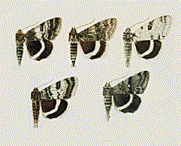Papers in the Biological Sciences

Alan Bond Publications
Document Type
Article
Date of this Version
4-2014
Citation
Kazuhiro Goto, Alan B. Bond, Marianna Burks, and Alan C. Kamil (2014) Visual Search and Attention in Blue Jays (Cyanocitta cristata): Associative Cuing and Sequential Priming. Journal of Experimental Psychology: Animal Learning and Cognition, 40 (2014), pp. 185–194; http://dx.doi.org/10.1037/xan0000019
Abstract
Visual search for complex natural targets requires focal attention, either cued by predictive stimulus associations or primed by a representation of the most recently detected target. Because both processes can focus visual attention, cuing and priming were compared in an operant search task to evaluate their relative impacts on performance and to determine the nature of their interaction in combined treatments. Blue jays were trained to search for pairs of alternative targets among distractors. Informative or ambiguous color cues were provided before each trial, and targets were presented either in homogeneous blocked sequences or in constrained random order. Initial task acquisition was facilitated by priming in general, but was significantly retarded when targets were both cued and primed, indicating that the two processes interfered with each other during training. At asymptote, attentional effects were manifested mainly in inhibition, increasing latency in miscued trials and decreasing accuracy on primed trials following an unexpected target switch. A combination of cuing and priming was found to interfere with performance in such unexpected trials, apparently a result of the limited capacity of working memory. Because the ecological factors that promote priming or cuing are rather disparate, it is not clear whether they ever simultaneously contribute to natural predatory search.


Comments
Copyright © 2014 American Psychological Association. Used by permission.